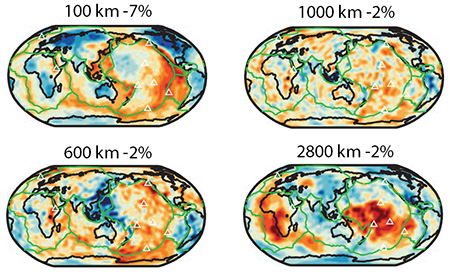Tomography

Maps of shear velocity perturbations (in %) at 100 km, 600 km (the transition zone), 1000 km and 2850 km (the core-mantle boundary region) depth in the mantle, according to model S40RTS. The shear velocity is low (high) compared to PREM in regions shaded red (blue). Shear velocity variations of more than 15% in the uppermost 100 km of the mantle are due to the ocean/continent variations and plate tectonics. High velocity anomalies in the transition zone indicate the position of slabs of subducted oceanic lithosphere. Broad low shear velocity structures beneath Africa and the central Pacific in the lower mantle are likely hot, but potentially stable thermo-chemical piles.
In collaboration with Jeroen Ritsema (University of Michigan), John Woodhouse (University of Oxford) and Hendrik van Heijst (Shell) we are used our new splitting functions data set to make a new tomographic mantle shear wave velocity model S40RTS. Combining 1100 normal mode splitting function measurements with 500,000 body wave and 20 million Rayleigh wave surface wave dispersion measurements, the new model S40RTS is being used to address questions regarding the Earth’s thermal and compositional heterogeneity. The model, codes to read the model coefficients, and GMT scripts for plotting cross-sections can be downloaded from Jeroen Ritsema’s website.
We then added compressional body wave data and our Stoneley mode measurements to make a new compressional model of the mantle, SP12RTS.
Key publications
- Mosca, I., L. Cobden, A. Deuss, J. Ritsema, and J. Trampert (2012). Seismic and mineralogical structures of the lower mantle from probabilistic tomography, Journal of Geophysical Research 117 (B06304), doi:10.1029/2011JB008851
- Ritsema, J., Deuss, A., van Heijst, H. J. and J. H. Woodhouse (2011). S40RTS: a degree-40 shear-velocity model for the mantle from new Rayleigh wave dispersion, teleseismic traveltime and normal-mode splitting function measurements, Geophysical Journal International 184(3), p.1223–1236
- Deuss, A., J. Ritsema, and H. van Heijst (2011). Splitting function measurements for Earth’s longest period normal modes using recent large earthquakes, Geophysical Research Letters 38 (4), doi:10.1029/2010GL046115
- Ritsema, J., van Heijst, H. J., Woodhouse, J. H. and A. Deuss (2009). Long-period body wave traveltimes through the crust: implication for crustal corrections and seismic tomography, Geophysical Journal International 179 (2), p.1255-1261

